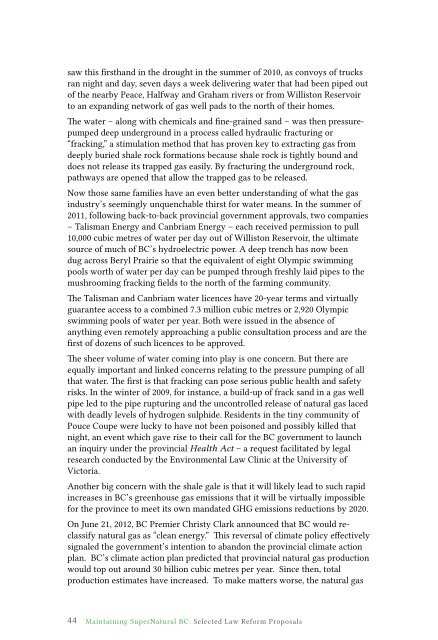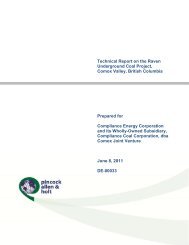Maintaining SuperNatural BC for Our Children - CoalWatch Comox ...
Maintaining SuperNatural BC for Our Children - CoalWatch Comox ...
Maintaining SuperNatural BC for Our Children - CoalWatch Comox ...
- No tags were found...
You also want an ePaper? Increase the reach of your titles
YUMPU automatically turns print PDFs into web optimized ePapers that Google loves.
saw this firsthand in the drought in the summer of 2010, as convoys of trucksran night and day, seven days a week delivering water that had been piped outof the nearby Peace, Halfway and Graham rivers or from Williston Reservoirto an expanding network of gas well pads to the north of their homes.The water – along with chemicals and fine-grained sand – was then pressurepumpeddeep underground in a process called hydraulic fracturing or“fracking,” a stimulation method that has proven key to extracting gas fromdeeply buried shale rock <strong>for</strong>mations because shale rock is tightly bound anddoes not release its trapped gas easily. By fracturing the underground rock,pathways are opened that allow the trapped gas to be released.Now those same families have an even better understanding of what the gasindustry’s seemingly unquenchable thirst <strong>for</strong> water means. In the summer of2011, following back-to-back provincial government approvals, two companies– Talisman Energy and Canbriam Energy – each received permission to pull10,000 cubic metres of water per day out of Williston Reservoir, the ultimatesource of much of <strong>BC</strong>’s hydroelectric power. A deep trench has now beendug across Beryl Prairie so that the equivalent of eight Olympic swimmingpools worth of water per day can be pumped through freshly laid pipes to themushrooming fracking fields to the north of the farming community.The Talisman and Canbriam water licences have 20-year terms and virtuallyguarantee access to a combined 7.3 million cubic metres or 2,920 Olympicswimming pools of water per year. Both were issued in the absence ofanything even remotely approaching a public consultation process and are thefirst of dozens of such licences to be approved.The sheer volume of water coming into play is one concern. But there areequally important and linked concerns relating to the pressure pumping of allthat water. The first is that fracking can pose serious public health and safetyrisks. In the winter of 2009, <strong>for</strong> instance, a build-up of frack sand in a gas wellpipe led to the pipe rupturing and the uncontrolled release of natural gas lacedwith deadly levels of hydrogen sulphide. Residents in the tiny community ofPouce Coupe were lucky to have not been poisoned and possibly killed thatnight, an event which gave rise to their call <strong>for</strong> the <strong>BC</strong> government to launchan inquiry under the provincial Health Act – a request facilitated by legalresearch conducted by the Environmental Law Clinic at the University ofVictoria.Another big concern with the shale gale is that it will likely lead to such rapidincreases in <strong>BC</strong>’s greenhouse gas emissions that it will be virtually impossible<strong>for</strong> the province to meet its own mandated GHG emissions reductions by 2020.On June 21, 2012, <strong>BC</strong> Premier Christy Clark announced that <strong>BC</strong> would reclassifynatural gas as “clean energy.” This reversal of climate policy effectivelysignaled the government’s intention to abandon the provincial climate actionplan. <strong>BC</strong>’s climate action plan predicted that provincial natural gas productionwould top out around 30 billion cubic metres per year. Since then, totalproduction estimates have increased. To make matters worse, the natural gas44<strong>Maintaining</strong> <strong>SuperNatural</strong> <strong>BC</strong>: Selected Law Re<strong>for</strong>m Proposals



